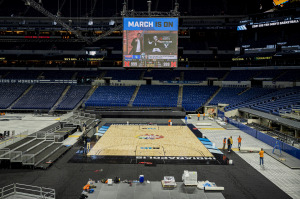Indiana reports 32 more deaths from COVID
Statewide hospitalizations due to COVID-19 rose from 692 on Wednesday to 730 on Thursday.
Statewide hospitalizations due to COVID-19 rose from 692 on Wednesday to 730 on Thursday.
The pickup in hiring lowered the unemployment rate from 6.3% to 6.2%, the Labor Department said Friday in its monthly jobs report. That is down dramatically from the 14.8% jobless rate of April of last year, just after the virus erupted in the United States.
Indiana Gov. Eric Holcomb sat wearing a face mask in the front passenger seat of an SUV while getting the shot in his right arm of the single-dose Johnson & Johnson vaccine being given during the drive-through clinic.

One of the biggest changes fans will see this year will be in ticket sales, which are being limited to one game at a time instead of multiple-game sessions.
Economists have forecast that job growth reached 175,000 last month, according to data provider FactSet. That would mark a sharp improvement over an average of just 29,000 jobs a month from November through January.
Federal Reserve Chair Jerome Powell suggested Thursday that inflation will pick up in the coming months but the rise would likely prove temporary and not enough for the Fed to alter its record-low interest rate policies.
The state said more than 633,000 Hoosiers had been fully vaccinated against COVID-19 as of Thursday. More than 1.06 million had received the first dose of a vaccination.
The revised figure released by the Labor Department on Thursday was slightly smaller than the 4.7% decline estimated a month ago. But it was still the biggest drop since the second quarter of 1981.
A limited number of spectators will be allowed to attend the Big Ten Conference’s men’s and women’s basketball tournaments in Indianapolis this month, the conference announced Thursday morning.
All Indiana teachers are now eligible for COVID vaccines under a new federal directive. Vaccines earmarked for educators are separate from the overall allocation the state receives, said Indiana State Department of Health Chief Medical Officer Lindsay Weaver.
More than 1.03 million Hoosiers—or about 15% of the state’s population of about 6.7 million—have received at least one dose of a COVID-19 vaccine, but it could take weeks or months to immunize the entire state, health officials say.
For three days starting Friday, the state will operate a drive-through vaccination clinic at the Indianapolis Motor Speedway, where thousands of eligible Hoosiers will be able to get a shot without leaving their car.
Under the new structure, the checks would phase out faster for those at higher income levels, compared to the way the direct payments were structured in President Biden’s initial proposal and the version of the bill passed by the House on Saturday.

The closure will be used by the Indianapolis Cultural Trail and the NCAA for various activities throughout the NCAA tournament.
The decision comes one day after the state opened up vaccinations to the 55-59 age group.
Statewide hospitalizations due to COVID-19 dropped from 765 on Monday to 731 on Tuesday, the lowest number since Sept. 12.
The additional signups came during the first two weeks of an extended enrollment period ordered by President Joe Biden to help more people find insurance amid the economic ripple effects caused by the coronavirus pandemic.
Among the most vulnerable not-for-profits, the study said, are those involved in arts and entertainment, which depend on ticket sales for most of their revenue, cannot significantly their reduce expenses and don’t typically hold much cash.
Despite the stepped-up pace of vaccine production, the work of inoculating Americans could extend well into the summer, officials said, depending both on the government’s capacity to deliver doses and Americans’ willingness to roll up their sleeves.

The airport will be ready for visitors in town for the tournament with new March Madness signage, NCAA-sanctioned pop-up retail shops and enhanced staffing.